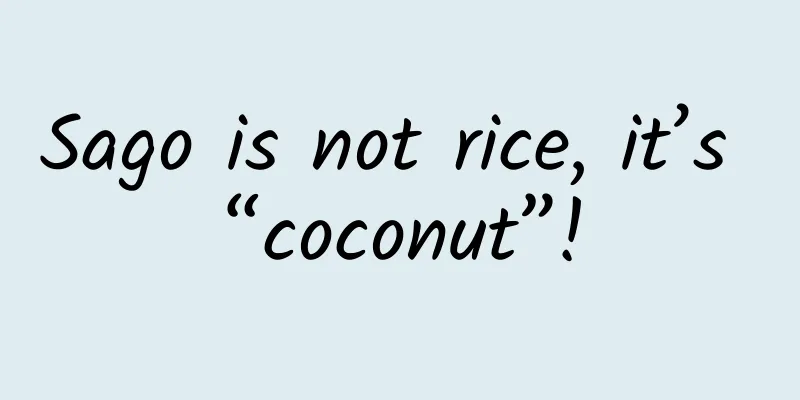Sago is not rice, it’s “coconut”!

|
How can we miss the icy cold desserts in the hot weather! There are many kinds of desserts, such as coconut, konjac, ice jelly, grass jelly, sago... Just looking at the names, it is difficult to guess what raw materials they are made of. In fact, behind these successful desserts, there is a hard-working plant! Coconut: Not a coconut fruit Contrary to what many people think, coconut flakes are not actually produced directly from coconuts, but are the product of bacterial fermentation of coconut water. Coconut | Judgefloro / wikimedia Coconut is the fruit of the coconut tree (Cocos nucifera). However, most of the coconuts sold in supermarkets are not whole coconuts. Most of the coconuts sold in inland cities have the exocarp and part of the mesocarp removed. The outermost layer of the coconut exocarp is the smooth green thin skin , the inner highly fibrous structure of the coconut palm is the mesocarp, and the innermost bony shell is the endocarp. The seed coat of coconut is very thin and close to the endocarp. Coconut with its outer peel still attached丨HRajib / wikimedia Coconut with its outer peel removed丨Petey21 / wikimedia So when we open a coconut, we are simultaneously opening the rind and the seed inside, exposing the endosperm directly inside the seed. Inside a mature coconut丨Rotational / wikimedia There are two forms of coconut endosperm. The outer layer is white solid endosperm , which is commonly known as coconut meat. Coconut shreds, coconut flakes, coconut milk , etc. are all processed from this solid endosperm. The inner cavity is filled with liquid endosperm, generally known as " coconut water ", which is the part of the coconut that can be drunk directly with a straw. It is also the raw material for making coconut fruit . Coconut water is liquid endosperm | Phu Thinh Co / wikimedia The method of making coconut jelly is to ferment Glucoacetobacter xylinum in coconut water. Using the sugars and other substances in it, Glucoacetobacter xylinum can produce a polysaccharide - bacterial cellulose. These bacterial cellulose floats on the surface of coconut water, and when accumulated, it forms a thick layer of white substance. After being fished out and further processed, it becomes the coconut jelly in the dessert shop. Coconut milk tea and pearl milk tea, which one do you pick? 丨Mz-Wang / Tuchong Creative Coconut is not only delicious, but also a good weight loss food. The main component of coconut is cellulose, which cannot be digested and absorbed by the human body, but it can enhance gastrointestinal motility and promote digestion, which has many benefits to the body. Konjac: Desserts and hotpot are its destinations Konjac looks like jelly and is chewy when eaten. Its name seems to have a certain charm. In fact, it has the same origin as the konjac silk we are very familiar with - konjac (Amorphophallus konjac). Konjac jelly丨sirooziya / wikimedia Cut konjac into small pieces | chidorian / wikimedia Konjac is a plant of the Araceae family, and the edible part is the underground tuber. Konjac tubers are rich in starch and konjac polysaccharide , which is the substance that makes konjac elastic. The above-ground part of the konjac plant also looks quite impressive: its inflorescence is wrapped in a crimson-hued spathe , and the bracts simulate the color of rotten meat. When it blooms, it also emits a foul odor, attracting carrion-eating insects for pollination...Okay, today's theme is desserts, so let's stop with the disgusting stuff. The crimson spathe of konjac丨BotBln / wikimedia Like coconut, konjac is also a popular diet food nowadays. But don't just chew the tuber, as most plants in the Araceae family are poisonous, and konjac is no exception. Eating raw konjac directly can cause acute poisoning, and in severe cases, death - the cause of death is mostly not due to the toxin itself, but due to suffocation caused by the swelling of the throat caused by poisoning. By the way, the same is true for eating taro raw , which is also from the Araceae family… Eating taro raw can also cause poisoning | David.Monniaux / wikimedia Konjac must be ground, boiled, washed and processed before being solidified into a jelly-like texture by adding lime. You can then cook or stew it, or make it into a delicate dessert. Taro vs. taro: Don’t confuse them In dessert shops, besides konjac, there is another more well-known type of taro: fragrant taro. Although it is also called taro, fragrant taro is not a relative of konjac or taro, but is very close to Chinese yam. Think about the yams (not potatoes) on the supermarket shelves. If you change the white to purple, it will basically look like taro, which is very different from taro in appearance. Yam丨Ubcule / wikimedia The scientific name of taro is Dioscorea alata, a plant of the Dioscorea genus of the Dioscorea family. Its Chinese name is ginseng shu . The iconic purple taro in dessert shops is a cultivated variety of ginseng shu, which has a unique vanilla aroma. Taro, also known as ginseng potato丨Badagnani / wikimedia The common white taro is food, and in some areas of southern China it is used as " Huai yam ". The above-ground part of taro is a herbaceous vine with heart-shaped leaves and bulbils in the axils, which is a common name for the yam family. Dioscorea leaves | Nonenmac / wikimedia If you want to show off in front of someone in a dessert shop, please remember the following words (otherwise, please skip them): Purple yam or Ube in English, Ubi-Kinampay (also known as Kinampay for short) from Bohol Province in the Philippines is the best among them. It is darker purple and more fragrant than ordinary taro; in addition, there are many varieties in the Philippines, such as kabus-ok, iniling, tamisan, baligonhon, binanag, binato, etc. Purple potato丨User_5d5937b2 / Tuchong Creative Even if you know all this, you may still not be able to eat authentic taro in dessert shops, because there are so many fake ones. Many people often confuse taro with purple sweet potato (purple sweet potato is a variety of sweet potato Ipomoea batatas that accumulates a lot of anthocyanins in its tubers ). The reason is simple: purple sweet potato is also purple, and its texture is similar to taro, so many shops will add purple sweet potato to make up the number when making taro desserts, and over time, the two are often confused. Sago: It turns out to be "coconut" powder The so-called sago is not actually rice, but is made from the starch produced by the sago palm (Metroxylon sagu). Sago palm and coconut belong to the same palm family, native to Southeast Asia, and look like both coconut and palm. Sigu coconut丨Rik Schuiling / TropCrop-TCS / wikimedia There is a lot of starch accumulated in the stem of the sago palm. People "scrape" the starch off, wash it, put it aside, and air it. When it is not completely dry, shake it like a Yuanxiao (Chinese rice dumplings), and it will become grains of sago, which can be added to desserts after being cooked. Sago dew丨Benjwong / wikimedia Let's talk about their family, Palmaceae, which is the only tree family among monocots in China. But in fact, their stems are different from dicots. They do not have a vascular ring of formation layer , but are scattered, so strictly speaking, they cannot be considered trees. Xiancao: It is really grass Grass jelly is a traditional summer dessert in Fujian, Taiwan and Guangdong. This black jelly-like food looks like it has nothing to do with grass. But in fact, it is made of "grass" - Mesona chinensis of the Lamiaceae family, also known as grass jelly in Taiwan, Malaysia and Singapore (hence the name of grass jelly). The production method is very simple. Use the stems and leaves of the grass jelly to dry and boil water, then add starch, and it will solidify into a jelly after cooling. Agar-agar grass丨Ronggy / wikimedia Grass Jelly丨Sjschen / wikimedia Guilinggao: There is really a turtle The color and texture of Guilinggao are similar to that of grass jelly, but you will find that it is very bitter after taking a bite, so it is usually served with a lot of sugar and condensed milk. The main ingredients of Guilinggao are "turtle" (Chinese grass tortoise, Chinemys reevesiis) and "ling" (Poria cocos, Wolfiporia extensa, or wild yam, Smilax glabra). The turtle's plastron is used to make Guiling Gao, which is called tortoise shell in traditional Chinese medicine. It is rich in animal collagen, which is the main factor that enables Guiling Gao to solidify into jelly. Poria cocos is the dried sclerotium of the fungus Poria cocos of the family Familiaceae. It often parasitizes on the roots of pine trees and is shaped like a sweet potato. | Trappem / wikimedia Poria cocos is a large fungus of the Polyporaceae family, parasitic on the roots of red pine. The sclerotium of Poria cocos, a dormant body composed of hyphae and nutrients, is used to make Guiling Gao , not the fruiting body used for reproduction like mushrooms and Ganoderma lucidum. The hyphae of Poria cocos absorb nutrients from the roots and surrounding areas to grow and form sclerotia; when the sclerotia develop to a certain extent, they will emerge from the surface and produce many white honeycomb-shaped fruiting bodies; after releasing spores, the fruiting bodies develop into mycelium and continue a new round of life history. Smilax glabra丨Stanley Chan / inaturalist The Chinese smilax is a plant called Smilax glabra . Smilax is very common and diverse in China's forests. Most of them are vines and have a common feature: a pair of tendrils grow in the axils of each leaf . The underground part of the Chinese smilax is the traditional medicine "Chinese smilax". Smilax glabra丨wikimedia Ice powder: It’s not a drug Although ice jelly is not available in dessert shops, it is a very common refreshing snack on the streets of southwestern provinces such as Sichuan and Yunnan. The main thing that makes ice jelly solidify into a jelly is pectin (one of the main components of the cell wall of higher plants), and the pectin is provided by Nicandra physaloides of the Solanaceae family. Flowers of Physalis pseudocarpa丨Flobbadob / wikimedia Physalis australis is a very common weed, and its most distinctive feature is its light blue bell-shaped flowers with purple spots and its sepals that swell into small lanterns. When making ice jelly, soak the seeds of Physalis australis in water, add lime water to the extract, and let it stand for a while until it solidifies. Then add brown sugar water and it can be sold on the street. Sichuan Ice Jelly丨Jory Junjun/TuChong Creative Author: Desert Porcupine |
<<: How do the ivy that can be seen everywhere under the viaduct "climb" up there?
>>: 8D Magic City: I thought I was on the first floor, but I was actually on the 27th floor?
Recommend
2022 new online super hit "Lao Tao Pinduoduo Operation Series Course"
2022 new online super hit "Lao Tao Pinduoduo...
Guangdong bans electric vehicles
The "Guangzhou Non-Motor Vehicle and Motorcy...
How to create a WeChat mini program for selling vegetables? How to sell vegetables through WeChat mini program?
Today's industries are diverse, and many new ...
How to complete OPPO bidding within ten days?
After changing to a new job, the first task was t...
Tourist's hair suddenly stood up, netizens reminded: Get out of here! Experts said: Don't run around!
Recently, in Turpan, Xinjiang Tourists' hair ...
Zhihu operation and promotion: How to quickly occupy the best promotion position on Zhihu?
The traffic matrix is accumulated, not achieved...
7.9 seconds to reach 100 km/h, maximum range 375 km! This is the only pure electric four-wheel drive SUV you can buy for 300,000 yuan
It is obvious that Chinese car consumers prefer S...
Uncle Zhuo's "Muscle Gaining Beginner's Course" systematically learns fitness and doubles the muscle gain effect
If you want to gain weight and become stronger, t...
Make Flyme more down-to-earth YunOS version Meilan system experience
The launch of Meizu Blue allowed Meizu to officia...
Apple quietly pushes the first beta version of iOS 14.7: iOS 14.6 will soon be released
This Tuesday, the iOS 14.6 RC candidate version, ...
The dimensional wall collapsed. The second dimension invaded the third dimension.
Audiences who have watched Nolan's "Inter...
Apple Dad’s 10 Marketing Skills That Won the “Outstanding Marketing Award”!
In the CMO Survey of global marketing executives,...
Crisis PR Guide for the Catering Industry
Whether you watched this year’s 315 Gala or not, ...
“The bigger the waves, the more fish there are”? However, the danger is even greater! 丨 Expo Daily
“The bigger the wind and waves, the more fish the...
Turkish President blasts iPhone 6 for weird reasons
Turkish President Recep Tayyip Erdogan, known for...








![Uncovering the magic number behind user growth [5]](/upload/images/67cc4476dd35c.webp)
